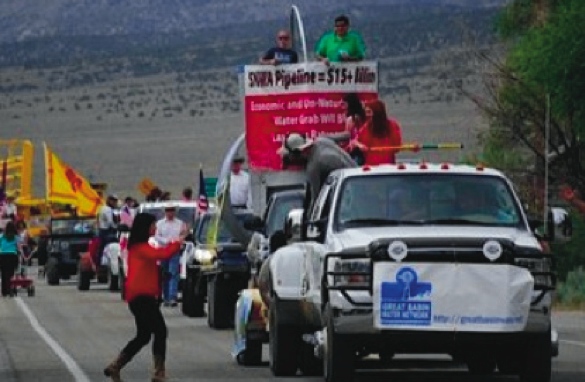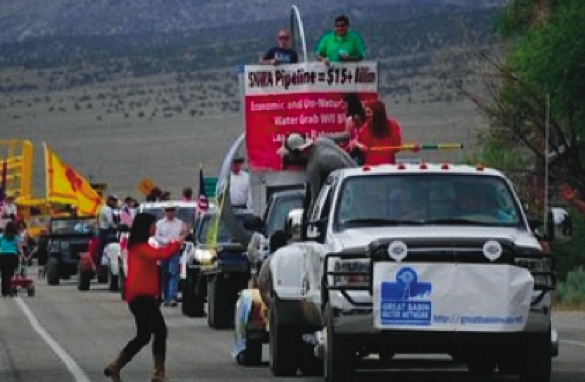The out manned and outgunned ranchers, farmers and just plain folks of rural Nevada and Utah won their third major victory against the Las Vegas city slickers of the SNWA when the Nevada Supreme Court refused to hear the appeal of District Judge Robert Estes ruling that voided the Las Vegas water grab last year.
Estes ruled in December 2013 that State Engineer Jason King had failed to establish adequate criteria for protecting the residents of eastern Nevada and western Utah from damages that might result from drawing down the groundwater to supply the Southern Nevada Water Authority with 84,000 acre-feet a year of groundwater from Spring , Cave, Dry Lake and Delamar valleys.
, Cave, Dry Lake and Delamar valleys.
 The state supreme court ruled that since Estes sent the case back to the state engineer the case was not appealable — yet.
The state supreme court ruled that since Estes sent the case back to the state engineer the case was not appealable — yet.
However the language Estes used to void the water rights made it clear that getting the rights back for Las Vegas could be very difficult.
“There are no objective standards to determine when mitigation will be required and implemented,” the judge wrote. “The Engineer has listed what mitigation efforts can possibly be made, i.e., stop pumping, modifying pumping, change location of pumps, drill new wells … but does not cite objective standards of when mitigation is necessary.”
location of pumps, drill new wells … but does not cite objective standards of when mitigation is necessary.”
 Estes concluded that if “it is premature to set triggers and thresholds, it is premature to grant water rights.”
Estes concluded that if “it is premature to set triggers and thresholds, it is premature to grant water rights.”
“If the Nevada State Engineer lacks information to set concrete triggers for monitoring and preventing or mitigating harmful impacts, then SNWA’s applications must be denied,” said Abby Johnson, president of GBWN. “The District Court decision reversed the State Engineer’s decision on all of SNWA’s water rights applications in Spring, Cave, Dry Lake and Delamar Valleys. The Supreme Court’s ruling requires that the State Engineer and SNWA accept that decision, and confront the deficiencies that Judge Estes held must be corrected before any of SNWA’s water rights applications can be granted,” Johnson continued .
.
“On a scale of one to ten this is a nine,” Johnson said in an interview with the High Desert Advocate.
 “SNWA has had 25 years to provide basic information proving that its proposed project to pump and pipe water out of these rural valleys would be sustainable and comply with the most basic requirements of Nevada’s water law. The fact that they not only have failed to produce such evidence in all that time, but also have gone on record saying repeatedly that they cannot produce such evidence, only goes to show this misguided proposal never has been and never will be scientifically defensible or legally permissible,” declared GBWN’s attorney, Simeon Herskovits of Advocates for Community and Environment.
“SNWA has had 25 years to provide basic information proving that its proposed project to pump and pipe water out of these rural valleys would be sustainable and comply with the most basic requirements of Nevada’s water law. The fact that they not only have failed to produce such evidence in all that time, but also have gone on record saying repeatedly that they cannot produce such evidence, only goes to show this misguided proposal never has been and never will be scientifically defensible or legally permissible,” declared GBWN’s attorney, Simeon Herskovits of Advocates for Community and Environment.
Rob Mrowka, senior scientist with the Center for Biological Diversity said, “Once again, the natural heritage that makes Nevada great has been saved by the courts from the ill-conceived and short-sighted plans of the SNWA.”
by the courts from the ill-conceived and short-sighted plans of the SNWA.”
 “All of the science actually shows that SNWA’s plan to pump groundwater out of these rural valleys and pipe it down to the Las Vegas Valley simply will not be sustainable and cannot avoid destroying existing water rights and the environment in the vast affected area,” said GBWN’s Johnson.
“All of the science actually shows that SNWA’s plan to pump groundwater out of these rural valleys and pipe it down to the Las Vegas Valley simply will not be sustainable and cannot avoid destroying existing water rights and the environment in the vast affected area,” said GBWN’s Johnson.
This decision marks the fourth consecutive victory of GBWN and allied opponents of SNWA’s controversial proposed project over SNWA in the courts in a real live “David v. Goliath” battle.
The high court’s decision is just the latest setback for the Negas water grab. Until last summer northern Nevada water appeared to be ready to be pumped down south. But just as the pipeline was all but laid bad things began to happen to the bad guys from Sin City.
 In addition to the Estes decision SNWA opponents scored a political victory of a sorts when Utah governor Gary Herbert In an 11th hour decision reversed himself and said he would not sign a controversial water-sharing agreement with Nevada that was strongly supported by the SNWA and strongly opposed by Utah ranchers and more recently by the LDS church.
In addition to the Estes decision SNWA opponents scored a political victory of a sorts when Utah governor Gary Herbert In an 11th hour decision reversed himself and said he would not sign a controversial water-sharing agreement with Nevada that was strongly supported by the SNWA and strongly opposed by Utah ranchers and more recently by the LDS church.
“At the end of the day, when it comes down to those people who have the most to lose — it’s their water, their lifestyle, their livelihood — I can’t in good conscience sign the agreement,” he said. “It’s that simple.”
Finally that year the Goshute and Shoshone Tribes, and their allies took the fight to a new level, requesting that the Federal District Court of Nevada “void the validity” of the Bureau of Land Management’s Environmental Impact Statement (EIS) and Record of Decision (ROD) and “suspend and enjoin any operation on the right-of-way” pending full compliance with federal environmental laws and trust
level, requesting that the Federal District Court of Nevada “void the validity” of the Bureau of Land Management’s Environmental Impact Statement (EIS) and Record of Decision (ROD) and “suspend and enjoin any operation on the right-of-way” pending full compliance with federal environmental laws and trust obligations to the Tribal Plaintiffs.
obligations to the Tribal Plaintiffs.

